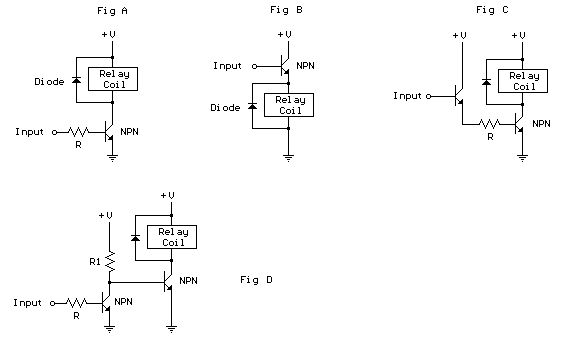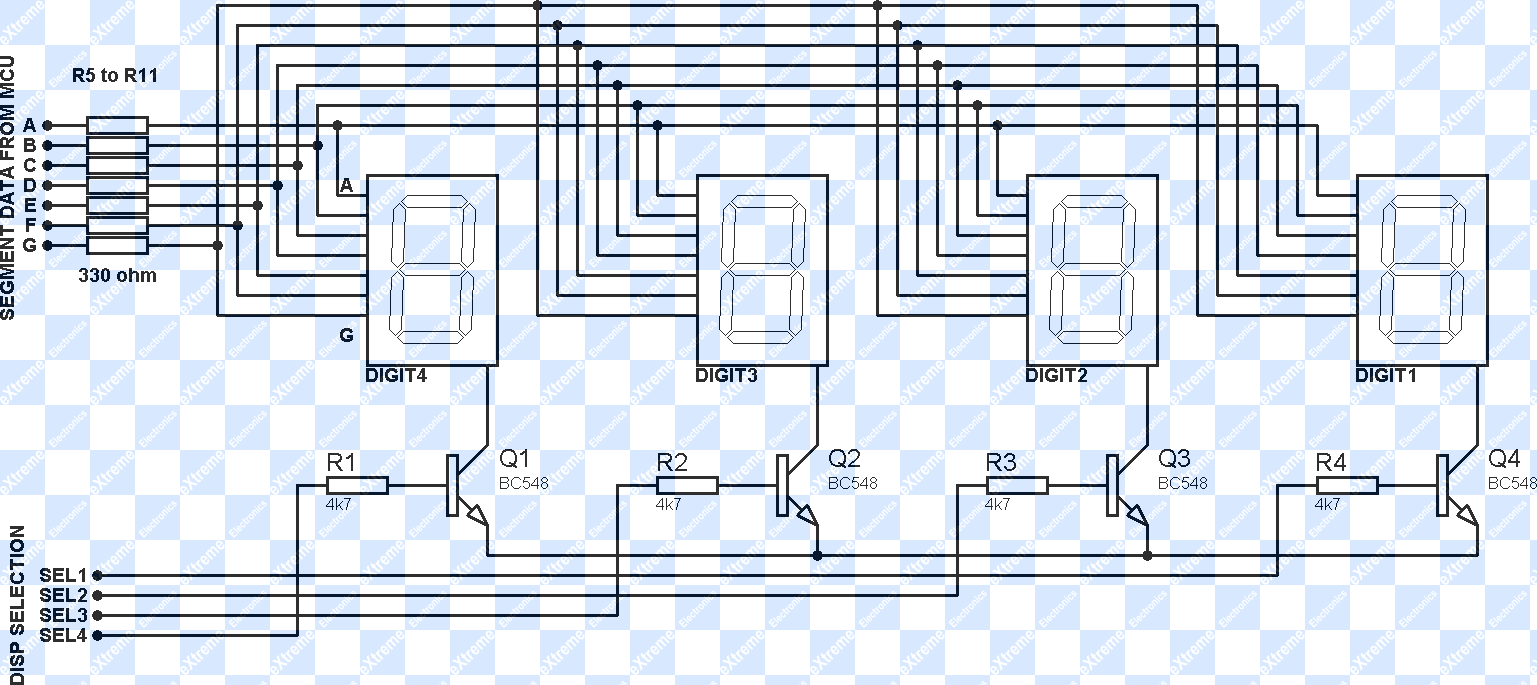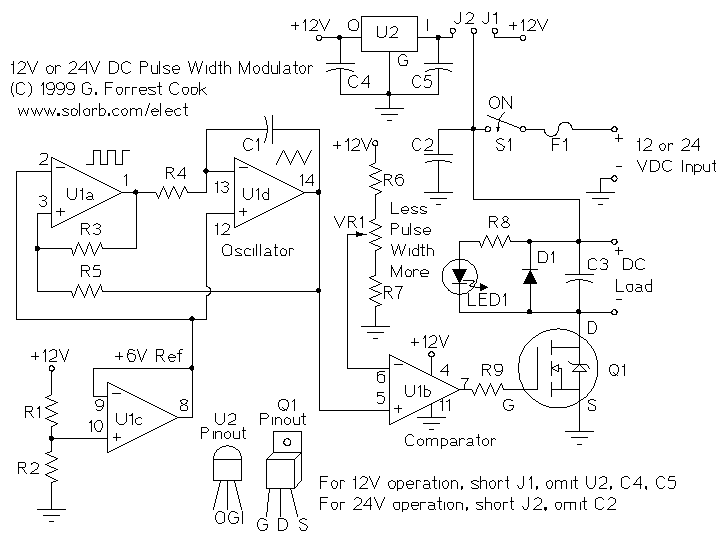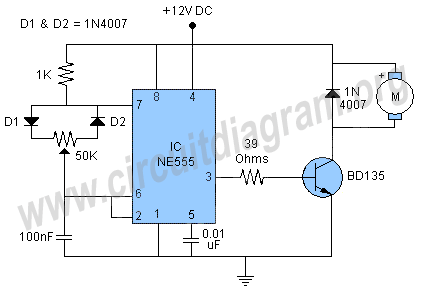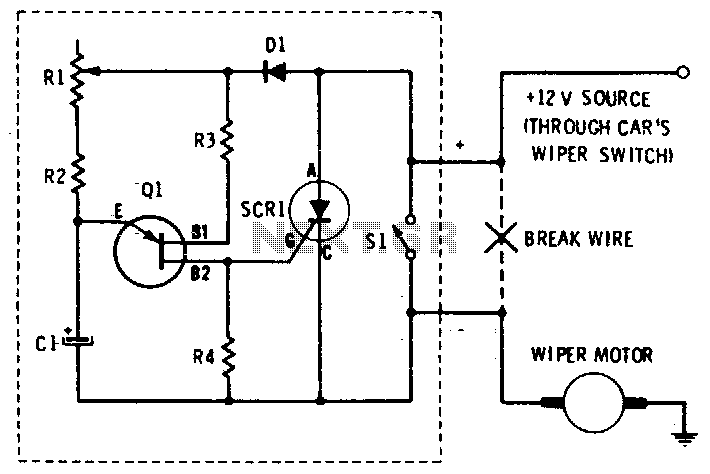
Discrete component motor direction controller
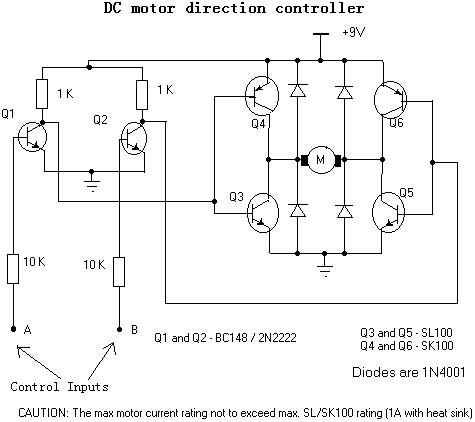
This circuit can control a small DC motor, like the one in a tape recorder. When both the points A and B are "HIGH," Q1 and Q2 are in saturation. Hence, the bases of Q3 to Q6 are grounded. Consequently, Q3 and Q5 are OFF, while Q4 and Q6 are ON. The voltages at both motor terminals are the same, and hence the motor is OFF. Similarly, when both A and B are "LOW," the motor is OFF. More: When A is HIGH and B is LOW, Q1 saturates, Q2 is OFF. The bases of Q3 and Q4 are grounded and that of Q4 and Q5 are HIGH. Hence, Q4 and Q5 conduct, making the right terminal of the motor more positive than the left, and the motor is ON. When A is LOW and B is...
This circuit utilizes a transistor-based configuration to control the operation of a small DC motor. The circuit logic is based on the states of two input control signals, A and B. The transistors Q1 and Q2 act as switches that determine the overall state of the motor based on the input signals.
1. **Motor Control States**:
- **Both A and B HIGH**: In this state, transistors Q1 and Q2 are fully saturated, which means they are conducting. This saturation grounds the bases of transistors Q3, Q4, Q5, and Q6. As a result, Q3 and Q5 remain OFF, while Q4 and Q6 turn ON. Since both terminals of the motor receive the same voltage, the motor remains OFF.
- **Both A and B LOW**: The same condition applies here, where Q1 and Q2 are not conducting, leading to the same grounding effect on Q3-Q6. Consequently, the motor remains OFF.
2. **Motor ON Conditions**:
- **A HIGH, B LOW**: In this scenario, Q1 saturates, allowing current to flow through it, while Q2 remains OFF. The bases of Q3 and Q4 are grounded, leading to Q3 being OFF. However, Q4 and Q5 receive HIGH signals, which allows them to conduct. This creates a potential difference across the motor terminals, making the right terminal more positive than the left, thus turning the motor ON.
- **A LOW, B HIGH**: This condition is not described in the input but would typically reverse the roles of A and B, allowing for the motor to potentially operate in the opposite direction, depending on the configuration of the transistors.
3. **Transistor Configuration**:
- The transistors are likely configured in a push-pull arrangement, where Q1 and Q2 control the direction of current flow through the motor, while Q3 to Q6 manage the switching states. This configuration is efficient for controlling motor direction and speed based on logic levels.
4. **Power Supply and Ratings**:
- The circuit should be designed to accommodate the voltage and current ratings of the DC motor, ensuring that the transistors can handle the load without overheating. Appropriate resistors may be necessary to limit base current to the transistors and protect them from damage.
Overall, this circuit provides a simple yet effective means of controlling a small DC motor using basic transistor switches, enabling straightforward control logic through the input signals A and B.This circuit can control a small DC motor, like the one in a tape recorder. When both the points A & B are "HIGH" Q1 and Q2 are in saturation. Hence the bases of Q3 to Q6 are grounded. Hence Q3,Q5 are OFF and Q4,Q6 are ON . The voltages at both the motor terminals is the same and hence the motor is OFF. Similarly when both A and B are "LOW" the motor is OFF. When A is HIGH and B is LOW, Q1 saturates ,Q2 is OFF. The bases of Q3 and Q4 are grounded and that of Q4 and Q5 are HIGH. Hence Q4 and Q5 conduct making the right terminal of the motor more positive than the left and the motor is ON. When A is LOW and B i 🔗 External reference
This circuit utilizes a transistor-based configuration to control the operation of a small DC motor. The circuit logic is based on the states of two input control signals, A and B. The transistors Q1 and Q2 act as switches that determine the overall state of the motor based on the input signals.
1. **Motor Control States**:
- **Both A and B HIGH**: In this state, transistors Q1 and Q2 are fully saturated, which means they are conducting. This saturation grounds the bases of transistors Q3, Q4, Q5, and Q6. As a result, Q3 and Q5 remain OFF, while Q4 and Q6 turn ON. Since both terminals of the motor receive the same voltage, the motor remains OFF.
- **Both A and B LOW**: The same condition applies here, where Q1 and Q2 are not conducting, leading to the same grounding effect on Q3-Q6. Consequently, the motor remains OFF.
2. **Motor ON Conditions**:
- **A HIGH, B LOW**: In this scenario, Q1 saturates, allowing current to flow through it, while Q2 remains OFF. The bases of Q3 and Q4 are grounded, leading to Q3 being OFF. However, Q4 and Q5 receive HIGH signals, which allows them to conduct. This creates a potential difference across the motor terminals, making the right terminal more positive than the left, thus turning the motor ON.
- **A LOW, B HIGH**: This condition is not described in the input but would typically reverse the roles of A and B, allowing for the motor to potentially operate in the opposite direction, depending on the configuration of the transistors.
3. **Transistor Configuration**:
- The transistors are likely configured in a push-pull arrangement, where Q1 and Q2 control the direction of current flow through the motor, while Q3 to Q6 manage the switching states. This configuration is efficient for controlling motor direction and speed based on logic levels.
4. **Power Supply and Ratings**:
- The circuit should be designed to accommodate the voltage and current ratings of the DC motor, ensuring that the transistors can handle the load without overheating. Appropriate resistors may be necessary to limit base current to the transistors and protect them from damage.
Overall, this circuit provides a simple yet effective means of controlling a small DC motor using basic transistor switches, enabling straightforward control logic through the input signals A and B.This circuit can control a small DC motor, like the one in a tape recorder. When both the points A & B are "HIGH" Q1 and Q2 are in saturation. Hence the bases of Q3 to Q6 are grounded. Hence Q3,Q5 are OFF and Q4,Q6 are ON . The voltages at both the motor terminals is the same and hence the motor is OFF. Similarly when both A and B are "LOW" the motor is OFF. When A is HIGH and B is LOW, Q1 saturates ,Q2 is OFF. The bases of Q3 and Q4 are grounded and that of Q4 and Q5 are HIGH. Hence Q4 and Q5 conduct making the right terminal of the motor more positive than the left and the motor is ON. When A is LOW and B i 🔗 External reference
Warning: include(partials/cookie-banner.php): Failed to open stream: Permission denied in /var/www/html/nextgr/view-circuit.php on line 713
Warning: include(): Failed opening 'partials/cookie-banner.php' for inclusion (include_path='.:/usr/share/php') in /var/www/html/nextgr/view-circuit.php on line 713
